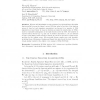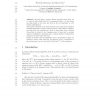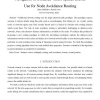76 search results - page 10 / 16 » A sieve algorithm for the shortest lattice vector problem |
DCC
2003
IEEE
14 years 7 months ago
2003
IEEE
Nguyen and Shparlinski recently presented a polynomial-time algorithm that provably recovers the signer's secret DSA key when a few bits of the random nonces k (used at each s...
CALC
2001
Springer
13 years 12 months ago
2001
Springer
We show that a positive definite integral ternary form can be reduced with O(M(s) log2 s) bit operations, where s is the binary encoding length of the form and M(s) is the bit-com...
INFOCOM
2007
IEEE
14 years 1 months ago
2007
IEEE
—Traditional network routing uses the single (shortest) path paradigm. This paradigm exposes sessions to various attacks along this path, such as eavesdropping, DoS attacks etc. ...
ASAP
2008
IEEE
14 years 1 months ago
2008
IEEE
NTRU is a public-key cryptosystem based on the shortest vector problem in a lattice which is an alternative to RSA and ECC. This work presents a compact and low power NTRU design ...
TON
2002
13 years 7 months ago
2002
Abstract-Dynamic routing protocols such as RIP and OSPF essentially implement distributed algorithms for solving the Shortest Paths Problem. The Border Gateway Protocol (BGP) is cu...



